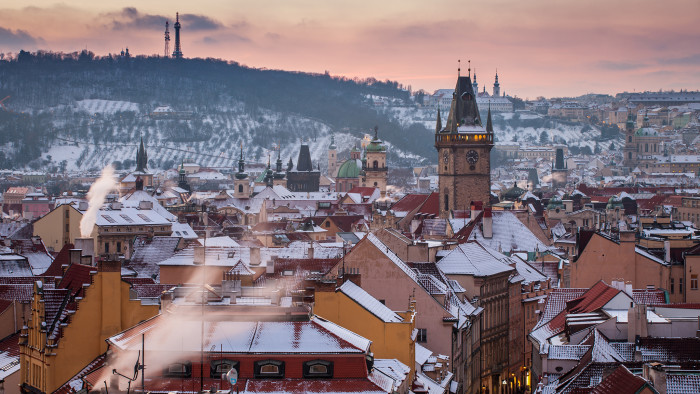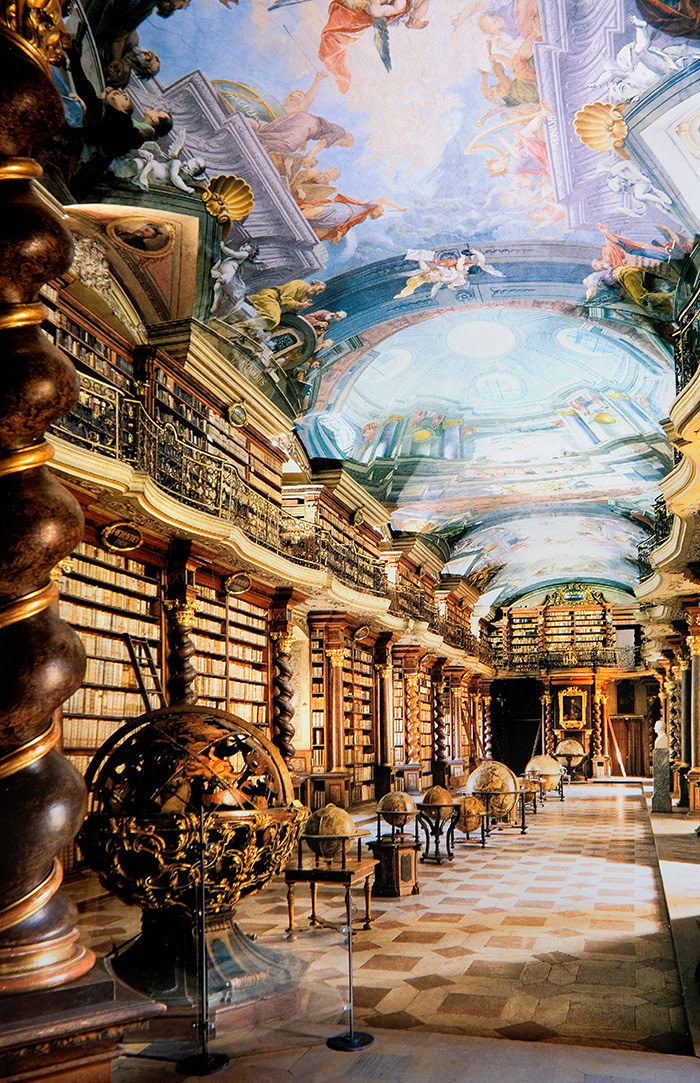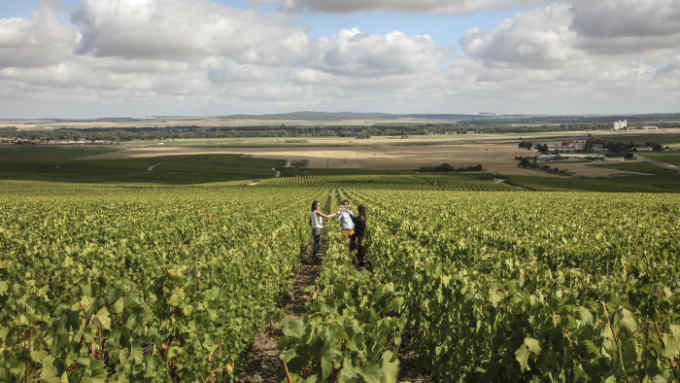Bohemian rhapsody: novelist Sarah Perry on her winter in Prague
Simply sign up to the Life & Arts myFT Digest -- delivered directly to your inbox.

On January 2 I arrived in the Czech Republic, to live for two months as the Unesco City of Literature Writer-in-Residence in Prague. I was given a small apartment overlooking the River Vltava, and from my bed I could lie and look up at the gilded crown of the National Theatre next door. There was a beautiful parquet floor, of the sort reserved for grand houses in England and ordinary apartments in Europe, and a long picture window with a shallow sill on which I sometimes leaned out to watch flocks of swans fly upriver.
I had never visited before, but the idea of Prague had occupied me since I was a teenager. I had once played the piano part in the school orchestra’s performance of “Vltava”, the river theme from Smetana’s symphonic poem Ma Vlast (it means “my country”). It is sweet and sentimental, not the sort of music any devotee of BBC Radio 3 could bring themselves to publicly admire but, to a 13-year-old in a small Essex town who had never been abroad, its rich unrolling melody was irresistibly seductive. I stole the sheet music, and played it at home, thinking of the Bohemian world I had never seen, but hoped to one day.
I had only the vaguest ideas of what eastern Europe had to offer — I suppose I thought of Klimt, or of immense posters by Alphonse Mucha advertising gardenia soap, and of poets smoking in cafés — but I was quite certain it would be an improvement on Chelmsford. The night I arrived, I found I could hear the birds on the banks of the Vltava from my bed, and threw open the windows, propped my laptop on the sill and listened to Smetana as I warily drew on the ferocious cigarettes I had bought at the airport.
I had intended to spend my time in Prague devoted to reading and writing, but my head was turned by music. I quickly learned that the English tendency towards anti-intellectualism (never confess to liking Proust or Poulenc unless you want to be teased) was quite alien to Prague, where — in, I suppose, a hangover from the Communist regime — tickets to the opera can be had for £5. In the eight weeks of my stay, I saw 10 operas, often alone, always dressing up just a little, and following the Czech tradition of taking a glass of sekt and a small open sandwich in the interval. At the National Theatre — which despite the name stages opera and ballet as well as drama — you are greeted by young women in immense velvet cloaks who direct you to your seat, and the audience consists as much of children in party dresses as grandes dames in their finery. It was built in 1881 and burnt down two months after the first performance, which was so grave a national catastrophe that Czechs from commoners to princes came together to fund a new building.
Away from the river — across Wenceslas Square, where you must negotiate your way through parties of British stags and hens — there is the formidable-looking State Opera House, and more opera at the baroque Prague Estates Theatre and the brutalist New Stage, annexed to the National Theatre. If you put your mind to it, you can see a different performance each night of the week, and everywhere you walk you will find yourself directed down alleys to ticket booths or irresistible theatre doors.

In the Old Town many of the churches are, if not precisely deconsecrated, certainly devoted more to the worship of music than of God. Several times I visited the Mirror Chapel at Klementinum, where the pipe organ was once played by Mozart, and where, in the late afternoon, musicians and sopranos perform programmes of Dvorak and Pachelbel before heading off for a night’s work in the opera houses. Even a walk across the Charles Bridge is a concert of its own: you can approach from the east bank to the sound of a man playing Bach on the rim of glasses of water set out on a table, and arrive on the west bank to Vivaldi on the violin.
By then I was already haunted by Melmoth — or, at any rate, by the idea of her. I had first read Charles Maturin’s Melmoth the Wanderer (1820) some years before, and had never forgotten my horrific encounter with the 150-year-old damned soul who wanders the world seeking out those in such dire straits that they will exchange places with him. I knew I wanted to pay homage to the novel, and that my Melmoth would be a woman. I knew too that I wanted to leave behind the flatlands of Essex and Norfolk, where my other books were set: I did not want to grow complacent, and barely stray from East Anglia’s borders. My Melmoth was elsewhere.

I did a great deal of walking. This was not easy, since the snow made the cobblestones treacherous. Each day I visited the Old Town Square, which still had its vast mechanical Christmas tree slowly spinning, and the market stalls selling painted wooden ornaments and paper cups of hot honey wine.
I knew, of course, that if I were ever to find the “real” Prague, I would certainly not find it there: the façades of the buildings around the square all had the quality of painted stage scenery, and I half expected someone to pull a rope and bring it all down. But I sat at the feet of Master Jan Hus, who in 1415 had been burnt alive as a radical religious and political martyr, and watched mice growing fat on scraps fallen from the bins. On the hour, every hour, crowds gathered by the vast, medieval, astronomical clock, awaiting its chime: I waited once, and couldn’t help laughing, since the climax of its parade of figurines was a little mechanical bird lifting its wings and giving a feeble crow. Later, I heard the local legend that the authorities had blinded the clockmaker with pins to ensure no other city could ever boast such a clock.

Young men in costumes blew vast soap bubbles that had an oily rainbow sheen; but a short stroll away, the walls of St Cyril and Methodius Cathedral were pocked with bullet-holes where Czech resistance fighters lost their lives. The flames of the martyrdom of Jan Hus had gone cold centuries ago, but just yards from where boats took tourists on river cruises with gingerbread and beer, student Jan Palach had burnt himself alive in protest against the Soviet invasion only 10 years before I was born. Every city, of course, is composed of these layers of art and architecture laid on histories of violence, but I had never spent so long in a city where the past was so fractured, so violent and so insistently present. Here and there, a small brass plate was fixed among the cobblestones — a stolpersteine, or stumbling-stone, bearing the name and birth date of Jewish Czechs taken from their homes to the camps, and the date on which they were murdered. In the Jewish Quarter, the walls of the Pinkas synagogue are inscribed with the names of 78,000 Bohemian and Moravian Jews who died in the Holocaust, and visitors to the Jewish cemetery bring stones and folded slips of paper to leave on the headstones.

Two months is by no means long enough to be anything but a tourist, yet it is long enough to become a tourist of a peculiar kind. I walked almost every day across the old Charles Bridge, with its blackened statues of saints and apostles, and practised my pitiful Czech with the help of a beggar who sat opposite the statue of St John of Nepomuk. In exchange for a handful of coins, he laughingly corrected my pronunciation, and in time grew sufficiently fond of me to permit me to give a biscuit to the little dog, called Tiger, he kept inside his coat. At the western end, where the bridge leads to roads lined with shops selling jewellery made from the little dark garnets mined in the Czech Republic, I took up the habit of standing on the parapet feeding biscuits to the jackdaws that gathered in the mornings.
After a week or so, I persuaded myself that they had come to know me by sight, since they seemed to be waiting for me, and later I learnt that jackdaws are canny things, and had marked me out as a soft touch from the start. I grew entranced by their glassy blue eyes, and their intelligent sideways looks, so that I would find myself thinking that if ever any bird were to feel when Melmoth was coming, it would be a jackdaw. The Czech for jackdaw is kavka, and I learnt that a black bird was painted on the sign that hung above Franz Kafka’s father’s shop. Just past the Charles Bridge, where flurries of jackdaws wait for scraps, is the Franz Kafka Museum, which, I found, is designed to make the visitor feel as disoriented and ill-at-ease as any Kafka character. In the cobbled square nearby, two articulated statues of naked men urinate on to a map of the Czech Republic and are always surrounded by laughing photographers.

Soon I began to feel that though I was still a stranger, I was a familiar one. I joined the National Library in Klementinum, a vaulted Gothic space with an immense black wrought-iron heater and an ornate plaster ceiling. (It had once been a Jesuit college, and in the evenings I would try and catch sight of a hooded ghost, but never did.) Within days I had acquisitioned a desk that I considered my own, and each morning sat in the café drinking coffee and eating a pastry filled with apples or poppyseed paste. Nothing could have been further from the expensively branded cafés in the British Library, selling artisanal sandwiches wrapped in plastic: whole ham hocks were kept warm on the counter, and bowls of potato salad could be had for a matter of pence. I recall feeling a disproportionate sense of pride when one of the women who commanded the coffee machine saw me in the queue, accepted my faltering Czech greeting without correction, and asked if I wanted my usual.
Cafés made a great show of having once been the haunt of Václav Havel, or Sarah Bernhardt. In the Café Louvre on Narodni Trida, you can eat plates of schnitzel and potato salad at the tables where Kafka and Einstein sat, while over the road in the Narodni Kavarna, the walls are inscribed with quotations from 20th-century Czech poets (here, the best breakfast consists of soft boiled eggs served in a glass with parmesan and chives, and an immense basket of bread). Often bars and cafés leave pencils and paper out on the tables, seeming to think it likely that drinkers would be struck by inspiration.

In the final week of my stay I sat in the Café Louvre drinking Turkish coffee and sketching a bare-branched tree full of watchful jackdaws; and later, back in Norwich, Prague already taking on the vivid uncanny quality of memory, I would draw jackdaws in the margins of my notebook. I had found Melmoth in Prague, and she followed me home.
Sarah Perry is the author of ‘After Me Comes the Flood’ and the award-winning ‘The Essex Serpent’. Her new book ‘Melmoth’ is published by Serpent’s Tail
Where to stay on a Prague winter break
Hotel BoHo In a city full of Baroque and Romanesque architecture — and with plenty of opulent historic hotels — the restrained styling and neutral colours of Hotel BoHo offer the traveller visual breathing space. Formerly an Art Deco post office, it now has 57 bedrooms in muted blues and greys, a spa, gym, sauna and library. It is handily situated near the Old Town Square. Doubles from €160; hotelbohoprague.com
Augustine Set around a beautiful courtyard, the Augustine’s whitewashed buildings are connected to St Thomas’s Church and a 13th-century monastery where Augustinian friars still live. But guests need not fear that their stay will be an ascetic one: they can enjoy the spa, then sip cocktails in the sundial garden or barrel-vaulted Refectory Bar. Olga Polizzi did the chic, white interiors with typical verve. Doubles from €177; marriott.com
Prague Stay For those wanting to experience the city like a local, this agency offers a good choice of quality apartments. Just off Wenceslas Square in the New Town (founded in 1348), for example, the open-plan Prague Panorama Penthouse has smart contemporary rooms and great views from its roof terrace. It sleeps six and costs from €200 per night. prague-stay.com
Four Seasons In a large neoclassical building beside the Vltava, this is a thoroughly indulgent option with views of the castle, the Charles Bridge and the Old Town Square. Elegant bedrooms have Bohemian crystal chandeliers and were designed by Pierre-Yves Rochon (whose long list of credits includes the Savoy in London). Special experiences on offer include after-hours tours of Karlstejn Castle, private dining on the hotel roof, or trips on the hotel’s own wooden riverboat. Doubles from €391; fourseasons.com
VIP Living houseboat This 12-metre-long floating home is moored at the Orthodocks Yacht Club on a narrow island in the Vltava, connected to the mainland by a bridge. It has floor-to-ceiling windows to maximise views and there is a large heated roof terrace. A captain can be provided to take you for a tour along the river. Sleeps two, from Kcs6,000 (£208); vipliving.cz
Follow @FTLifeArts on Twitter to find out about our latest stories first. Subscribe to FT Life on YouTube for the latest FT Weekend videos
Letter in response to this article:
Prague is in central Europe / From Dr Richard Carter, London SW15, UK

Comments